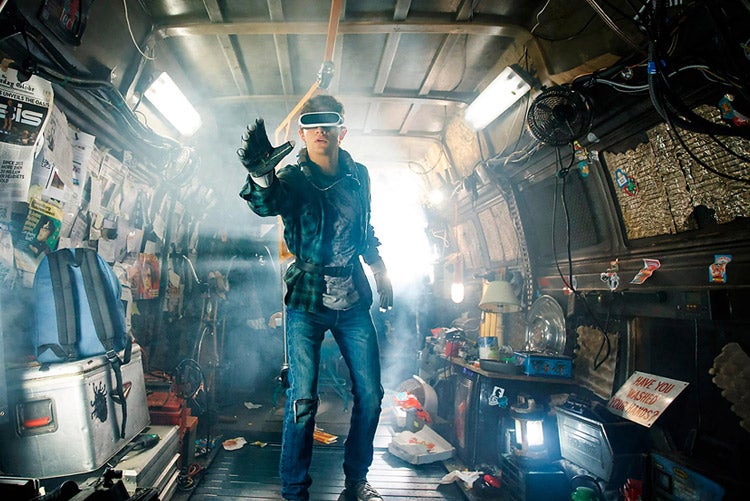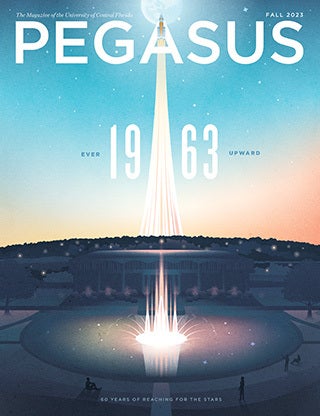You know the sequence. You strap on a pair of virtual reality goggles. There’s a short pause as your eyes send a message to your brain, and you’re in another place. Everything is so clear. So complete. So real. The VR experience is escapism at its best. Or is it?
If Steven Spielberg’s latest movie, Ready Player One, is even a hint of what’s to come, then we have barely seen how far VR could take us from our living rooms. In the movie, characters use VR to transport everything but their bodies to a sort of utopian world. The pristine environment with no poverty and a near-perfect community are sharp contrasts to the realities of the real setting in the year 2045. It is Hollywood, so the storyline eventually includes greed, lust and all-out conflict. But it all starts with what was originally designed for good — those goggles.
UCF Professor Tom Carbone says we’re barely scratching the surface of VR’s capabilities when it comes to uniting people who are separated geographically.
And this opens the door for the question: How is VR technology likely to be used in the years to come — as a tool to isolate and serve the self, or as a way to bring people together and make a positive impact?
“Interactive entertainment is already being used to create communities — it’s been shrinking the world for years now,” says Tom Carbone, technical director of the Florida Interactive Entertainment Academy at UCF. “Developers of VR are pushing the envelope in all kinds of ways to help people.”
He says we’re barely scratching the surface of VR’s capabilities when it comes to uniting people who are separated geographically. It might look far different than what we’re seeing today. And to think, it all started with video games 30, 40 years ago.
Who would have imagined?
Carbone has been on the leading edge of virtual reality. He came to UCF when FIEA was launched in 2005 as one of the first programs of its kind in the nation. Until that time, he had been a lead programmer for the widely popular Madden NFL video-game series. He shifted careers as singularly focused video gaming was becoming more interactive and showing potential to transform how we conduct business, education and, yes, relationships.
“The level of immersion with VR goggles makes social interaction possible where it was previously impossible, in all kinds of situations,” Carbone says.
“The level of immersion with VR goggles makes social interaction possible where it was previously impossible, in all kinds of situations,” Carbone says.
He has never bought into the negative portrayal of VR in movies. The antagonist using VR to control society in The Matrix. A player going on a VR crime spree in Virtuosity. Or all the way back to 1982, when Tron introduced us to the danger of getting lost — literally, figuratively and virtually — in a game.
The truth is users can choose to take VR into a corner and disappear for hours, same as we can with a smartphone. But there is no app that can take you skydiving or mountain climbing or fishing while at the same time connecting with others.
“Naysayers have feared the ‘addiction’ of interactive entertainment would be a negative force on society by pulling people apart,” Carbone says. “Players can ‘zone out’ for a while, just like we do at movies or when we go bass fishing. But to see VR in only that context is shortsighted.”
“Naysayers have feared the ‘addiction’ of interactive entertainment would be a negative force on society by pulling people apart,” Carbone says. “But to see VR in only that context is shortsighted.”
The big VR picture has begun stretching far beyond the objectives of personal gratification, too. For example, it’s being applied to real-life medical situations — combatting mental conditions through positive interaction and allowing doctors to help perform surgeries from remote locations.
To support these types of societal initiatives, Carbone created a FIEA class called GameLab. In it, students learn to work with non-gaming experts such as doctors, teachers and researchers. The collaboration creates a progressive cycle. The students enjoy the work. Which means they’re motivated to generate outside-the-box ideas. The ideas feed more collaboration. Who knows where it all leads?
The class is a living illustration of what we can do with VR. Not just to isolate or escape — although there’s nothing wrong with some of that. But to connect like never before. And maybe, just maybe, to help solve problems in the real world.





